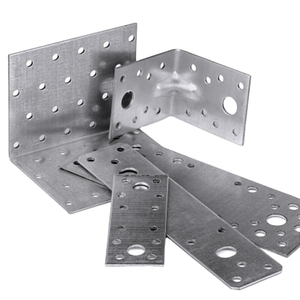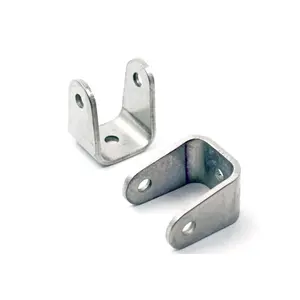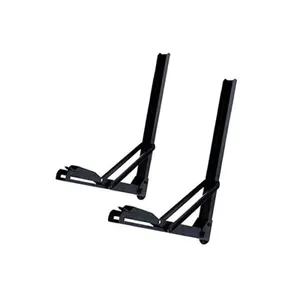Introduction
Embarking on a DIY project can be an exciting endeavor, but the success of your project often hinges on the details. One such detail that can make a significant difference is the use of metal brackets for wood. These versatile tools, available in a variety of types and sizes, provide robust support and stability to your wooden structures. Whether you're constructing a bookshelf, mounting heavy equipment, or designing a piece of furniture, the right metal bracket can revolutionize your project. This article delves into the world of metal brackets for wood, exploring their types, benefits, and how to choose the right one for your project. We'll also guide you through the installation process and highlight common mistakes to avoid.
Understanding Metal Brackets for Wood
Metal brackets for wood beams are a common way to attach wooden beams to walls. They come in various types such as steel joist hangers, corner brackets, beam brackets with or without lip, and invisible beam brackets. Each bracket corresponds to a specific beam size. These brackets are made of galvanised steel, making them very strong. They are easily mounted with chipboard screws and are provided with mounting holes for versatile applications. A wide range of these brackets is available at attractive prices on Alibaba.com.
Types of Metal Brackets
Metal brackets come in a variety of types, each designed for specific applications. Some popular types include the Sheet Metal Stamping Stainless Steel Precision Bracket, which can be customized to different angles. There's also the Metal Shaped Bracket, a U-shaped hardware ideal for specific stamping needs. Other types include the Stainless Steel Custom Sheet Metal Fabrication Bracket, Pergola Brackets for wood beams, and different types of Cast Iron Metal Swing Shelf Brackets. Each type offers unique features and benefits, making them suitable for various projects.
Choosing the Right Bracket for Your Project
Choosing the right bracket for your project involves understanding the different types and their applications. L-brackets, the most common type, are ideal for corner connections, providing stability to structures like bookshelves. U-brackets are often used in pipe support, while Z-brackets are typically applied in installations requiring a suspended component. Gusset Brackets, on the other hand, are used in architectural and interior design for both strength and visual appeal. The choice of bracket depends on the functional requirements and aesthetic considerations of your project.
Benefits of Using Metal Brackets in DIY Projects
Adjustable angle brackets, a type of metal brackets, offer a range of benefits due to their customizable nature and versatility. They provide precise customization and versatility for various applications, including DIY projects. Adjustable angle brackets offer adaptability, allowing for angle changes if required. They save costs and storage space by eliminating the need for multiple fixed-angle brackets. These brackets enable precise angle adjustments, minimizing the risk of miscalculations and subsequent re-work. They are designed for user-friendly installation, reducing the complexity and time required for setup. Adjustable angle brackets have revolutionized structural support, providing a flexible solution for construction, furniture design, and DIY projects.
Enhanced Durability and Stability
Sheet metal brackets offer excellent durability and stability, making them a crucial component in various industries. Their strength comes from sheet metal, a versatile material that can be formed into various sizes and thicknesses. The use of sheet metal in crafting brackets ensures robustness in various application scenarios, from mounting heavy equipment to supporting shelves. The intersection of functionality and aesthetics that sheet metal brackets provide is truly remarkable, underlining their importance in our day-to-day lives.
Versatility and Aesthetic Appeal
Metal brackets for wood not only provide structural support but also add aesthetic appeal to your projects. Their sleek design and metallic finish can complement any decor style, making them a popular choice for both functional and decorative purposes.
Step-by-Step Guide to Installing Metal Brackets
Installing metal brackets for wood is a straightforward process. First, plan the placement of your brackets and shelves before drilling any holes. Use a power drill to pre-drill the holes for the brackets. Finally, secure the shelving brackets with their included hardware. This process ensures your shelves are sturdy and can support whatever you store on them. Remember to check the level of your shelving brackets multiple times throughout the installation process to ensure your shelves are flat and even.
Required Tools and Materials
Mountmaking requires a selection of standard tools for basic fabrication. Quality counts, so don’t sell yourself short when purchasing your tools. Some essential tools include pliers with jaws that open parallel to each other, a bench vise for creating complex bends, and grinders for fast material removal and finishing. For larger tasks, a general-purpose woodworking saw, a variable speed drill press, and a versatile sander are recommended. A shop vacuum with a HEPA filter can help maintain a healthy work environment. More expensive tools like a Milling machine or Lathe can further enhance your mount designs.
Installation Process
Installing metal brackets for wood involves a few key steps. First, align the bracket with the stud or drywall, ensuring it's level. Mark the pilot hole locations. Drill the pilot holes, then secure the bracket using appropriate screws. If mounting to drywall, use drywall anchors for added stability. Repeat the process for the second bracket, ensuring it's level with the first. Once brackets are secure, place the shelf atop and drill pilot holes in the underside of the shelf. Finally, fasten the shelf using flat head screws. Remember, the process may vary slightly based on the specific type of metal bracket and the surface you're mounting it to.
Common Mistakes to Avoid When Using Metal Brackets
One common mistake when using metal brackets is not considering the thermal and moisture management of the installation site. In some cases, the brackets were installed directly against wood sheathing, potentially leading to condensation and moisture accumulation, which could cause the wood to rot. Another issue was the potential for the brackets to act as a conduit for rain, posing a flashing problem. These issues underline the importance of careful planning and consideration of the installation environment when using metal brackets.
Incorrect Bracket Size
Choosing the correct size of metal brackets for your wood shelves is crucial. Using shorter brackets for a deeper shelf can lead to problems. The carrying capacity of the bracket may be reduced, and the unsupported edge of the shelf might break under heavy load. The load placement also becomes a critical factor. The shelf and its load can be treated as having a well-established load limit when the bracket extends to the edge of the shelf. However, things become more complicated as the shelf extends beyond the end of the bracket, creating a second bending moment or point between the shelf and the bracket.
Over-tightening Screws
Over-tightening screws when installing metal brackets for wood can lead to serious issues. It may seem like a simple task, but applying excessive force can result in stripping and snapping screws, and failed fasteners. If you exceed the torque settings in an attempt to prevent your fastener from coming loose, it causes further damage. Over time, you’ll notice thread damage, snapped heads, and stripping, which can lead to safety complications. To avoid this, always adhere to the torque settings specified by the manufacturer.
Conclusion
In conclusion, metal brackets for wood are an indispensable tool in DIY projects, offering a blend of strength, versatility, and aesthetic appeal. Understanding the different types of brackets and their specific applications can help you choose the right one for your project. Moreover, knowing how to install them correctly and being aware of common mistakes can ensure the longevity and stability of your structures. Whether you're a seasoned DIY enthusiast or a beginner, the power of metal brackets can truly revolutionize your projects, turning your ideas into sturdy, functional, and visually appealing realities.

































 浙公网安备 33010002000092号
浙公网安备 33010002000092号 浙B2-20120091-4
浙B2-20120091-4